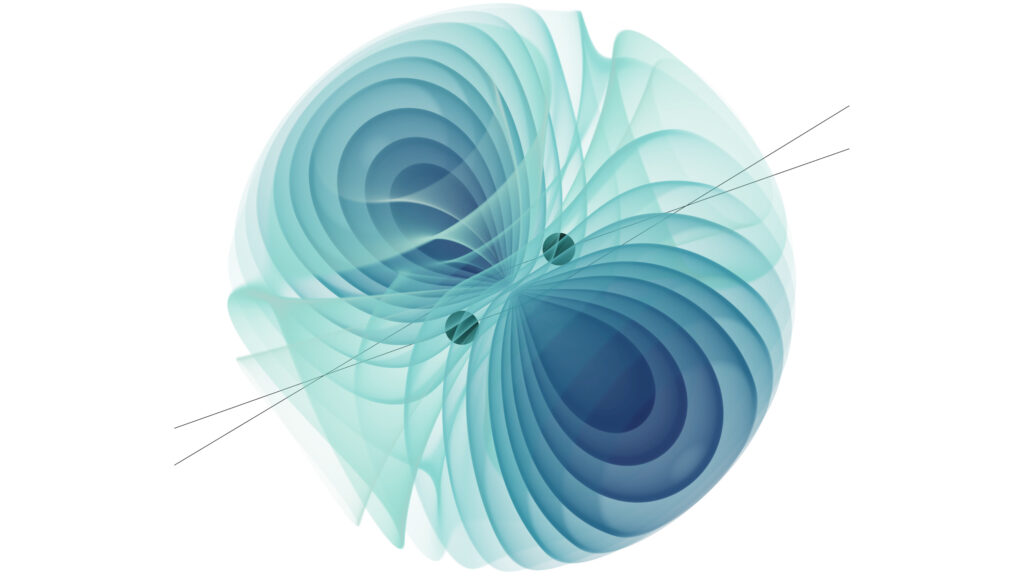Quarks are the ultimate building blocks of visible matter in the universe.
If we could zoom in on an atom in your body, we would see that it consists of electrons swarming in orbits around a nucleus of protons and neutrons. And if we could zoom in on one of those protons or neutrons, we’d find that they themselves are made up of a trio of particles that are so small that they have almost no size at all, and are little more than points. These point-like particles are the quarks.
Quarks are elementary particles. Like the electron, they are not made up of any other particles. You could say that they are on the ground floor of the Standard Model of particle physics.
Related: Strange quark star may have formed from a lucky cosmic merger

Keith Cooper
Keith Cooper is a freelance science journalist and editor in the United Kingdom, and has a degree in physics and astrophysics from the University of Manchester.
The discovery of quarks
The existence of quarks was first theorized in 1964 in the work of two physicists, Murray Gell-Mann (opens in new tab) and George Zweig, who were both at the California Institute of Technology (CalTech) but who came to the conclusion that quarks exist independently of one another. Contrary to how science is often portrayed in the media, Gell-Mann and Zweig’s conclusions were not an “a-ha!” moment but were instead built on the back of many years of hard work and careful discoveries by the particle physics community.
Related stories:
By the 1950s, physicists were building up a library of known particles. It was a bit like botany, cataloging the various types and their properties, but what was missing was an underlying theory behind their existence. This theory ultimately became known as the Standard Model, but in order to get there several vital discoveries had to be made, including that of quarks.
Most puzzling was the existence of particles called hyperons, which were unstable and decayed very quickly, but not into the particles they were expected to decay into. Gell-Mann realized that there must be an unknown quantum property at work, which he named “strangeness” because of the unexpectedness of it all.
Quantum numbers, like strangeness, charge and spin, have to be conserved. If a particle with a specific quantum number decays, then its by-products must add up to those quantum numbers that the decayed particle had. Moreover, the quantum numbers of a given particle have “degrees of freedom” — basically the range of values that these numbers can have. These degrees of freedom are called multiplets, and the pattern in which these multiplets could be arranged between different particles led Gell-Mann and Zweig to believe that the particles and their multiplets could be explained if each particle was formed from two or three smaller particles.
Zweig called these tiny, elementary particles “aces”, but the name didn’t catch on. Gell-Mann, who was ever one for cooky and memorable names, called them quarks, derived from a line in James Joyce’s experimental novel, Finnegan’s Wake: “Three quarks for Muster Mark!” In the novel, the quarks refer to the three children of the main character, Mr Mark.
These quarks were referred to as “up”, “down” and “strange” quarks. The up and down doesn’t really refer to anything, while the strange quark had a quantum number of strangeness of –1, hence why it is called “strange”, whereas the up and down quarks have a strangeness of 0.
Quarks in quantum physics

(opens in new tab)
Although the theory was clever, it didn’t immediately catch on because there was no experimental evidence for quarks. This came four years later in 1968 at the Stanford Linear Accelerator Center (opens in new tab) (SLAC) in California. Experimenters fired electrons, and then later muons, at protons, and found evidence that the electrons and muons were scattering off three smaller particles contained within the protons, each of these smaller particles having their own electric charge. These particles are the quarks.
It turns out that there are actually six types, or flavors, of quarks in total. Besides the up, down and strange quarks, there are also “charm”, “top” and “bottom” quarks. Each one has its own set of quantum numbers, and their masses are very different, with the up and down quarks being the least massive, and the top quark being the heaviest with a mass over 61,000 times more massive than the up quark. Why it should be so massive is not fully understood, but it does quickly decay into less massive quarks. The only reason scientists know that the likes of the top and bottom quarks exist is because particle accelerators such as the Large Hadron Collider are able to produce them briefly.
Adding to the difficulty in studying quarks is the fact that, under normal conditions, they do not exist alone. They are always bound together by the strong nuclear force, which allows them to form composite particles called hadrons. Particles made of two quarks are called mesons, and particles made of three quarks are called baryons, which include protons (two up and one down quark) and neutrons (one up and two down quarks). There are particles called tetraquarks that are made of four quarks, and pentaquarks that have five quarks, and some of them are almost stable (opens in new tab), but do eventually decay.
To fit into quantum physics theory, the behavior of quarks is governed by a model called quantum chromodynamics (opens in new tab), or QCD for short. The “chromo” in the name refers to “color” — not as in red, green or blue, but the name given to a particular quantum number that quarks possess. Think of color as playing the same role in the strong force as electric charge plays in the electromagnetic force. So, like colors repel and unlike colors (i.e. a color and its anti-color) attract, forming stable pairs of quarks, and like other quantum numbers, it must also be conserved.
The Big Bang and the quark–gluon plasma

(opens in new tab)
The strong force that binds quarks inside hadrons is carried by another kind of tiny elementary particle called gluons, which are exchanged between the quarks. To separate individual quarks requires an enormous amount of energy (it’s not called the strong force for no reason). This amount of raw energy only existed in nature about 10 billionths of a second to about a millionth of a second after the Big Bang, when the temperature was approximately 3.6 trillion degrees Fahrenheit (2 trillion degrees Celsius (opens in new tab)). During this brief, early period, the baby universe was filled with a form of matter known as a quark–gluon plasma, a particle soup of free-floating quarks and gluons. As the temperature and pressure quickly dropped as the baby universe expanded, the quarks became bound together, forming hadrons that ultimately formed the basis of all visible matter that we see today in the cosmos, from stars and galaxies to planets and people.
Although the quark–gluon plasma only existed 13.8 billion years ago in the immediate aftermath of the Big Bang, scientists have successfully recreated it in particle accelerator experiments by smashing two heavy nuclei, such as that of lead, into each other close to the speed of light. The first time that this was achieved was at CERN’s Super Proton Synchrotron (opens in new tab) in 2000.
As such, studying quark-gluon plasmas in particle accelerator experiments is an important way of better understanding the conditions in the universe in the aftermath of the Big Bang (opens in new tab).
Quark stars
The one other location in nature where conditions could be so extreme that quarks become unbounded is in a hypothetical object called a “quark star”.
If they exist, then quark stars are a kind of extreme neutron star, which are the most compact objects known in the universe that haven’t collapsed under gravity to form a black hole. A neutron star is born in a supernova, which is a violent explosion signaling the destruction of a massive star. While the outer layers of the star are blown away, the star’s core collapses under gravity and the pressure there becomes so great that protons with their positive electric charge merge with negatively charged electrons, their charges canceling out to form neutral neutrons. Neutron stars are about 6 miles (10 kilometers) in diameter, and a spoonful of neutron star material can have as much mass as a mountain.
However, theoretically, it may be possible for the cores of dying stars to become even more compact. In this scenario, neutrons would break apart, releasing their quarks to freedom. This would be a quark star.
However, for now, quark stars remain purely hypothetical; astronomers have not conclusively discovered one yet, although there are a handful of candidates that appear to have slightly different properties to ordinary neutron stars, such as a smaller diameter and a greater mass.
One candidate is an object that actually wasn’t formed in a supernova but from the merger of two neutron stars that produced a gravitational-wave event known as GW 190425 (opens in new tab), which was picked up by the LISA and Virgo gravitational-wave detectors here on Earth in 2019. The mass of the merged object is between 3.11 and 3.54 solar masses. This is too massive to be a neutron star (which in theory can’t get more massive than about 2.4 solar masses) but isn’t massive enough to be a black hole (which needs to be about five solar masses at minimum). Could it be a quark star instead?
One other possibility is that some neutron stars could be hybrid objects, with ordinary neutron star material in their outer layers and quark matter deep in their cores (opens in new tab).
Follow Keith Cooper on Twitter @21stCenturySETI. (opens in new tab) Follow us on Twitter @Spacedotcom (opens in new tab) and on Facebook (opens in new tab).
Additional resources
Read more about quarks with these resources from CERN (opens in new tab). Learn more about the discovery of quarks with CERN (opens in new tab) and explore the quarks and gluons in more detail with the Department of Energy (opens in new tab).
Bibliography
The First 3 Minutes: A Modern View of the Origin of the Universe by Steven Weinberg (1977, revised edition 1993, Harper-Collins)
Particle Physics by Brian R. Martin (2011, One-World Publications)
Crease, R. P. (June 17, 2019). Murray Gell-Mann (1929–2019). Nature News. Retrieved November 1, 2022, from https://www.nature.com/articles/d41586-019-01907-y (opens in new tab)
First observation of quark-gluon plasma? American Physical Society. (1998, July). Retrieved November 1, 2022, from https://www.aps.org/publications/apsnews/199807/observation.cfm (opens in new tab)
Fritzsch, H. (September 27, 2012). The history of QCD. CERN Courier. Retrieved November 1, 2022, from https://cerncourier.com/a/the-history-of-qcd/ (opens in new tab)
Lopes, A. (June 2, 2020). Neutron stars show their cores. CERN. Retrieved November 1, 2022, from https://home.cern/news/news/physics/neutron-stars-show-their-cores (opens in new tab)
Rayner, M. (July 29, 2021). New tetraquark a whisker away from stability. CERN Courier. Retrieved November 1, 2022, from https://cerncourier.com/a/new-tetraquark-a-whisker-away-from-stability/ (opens in new tab)
Recreating big bang matter on Earth. CERN. Retrieved November 1, 2022, from https://home.cern/news/series/lhc-physics-ten/recreating-big-bang-matter-earth (opens in new tab)
SLAC Home Page. SLAC National Accelerator Laboratory. Retrieved November 1, 2022, from https://www6.slac.stanford.edu/ (opens in new tab)
The Super Proton Synchrotron. CERN. Retrieved November 1, 2022, from https://home.cern/science/accelerators/super-proton-synchrotron (opens in new tab)


